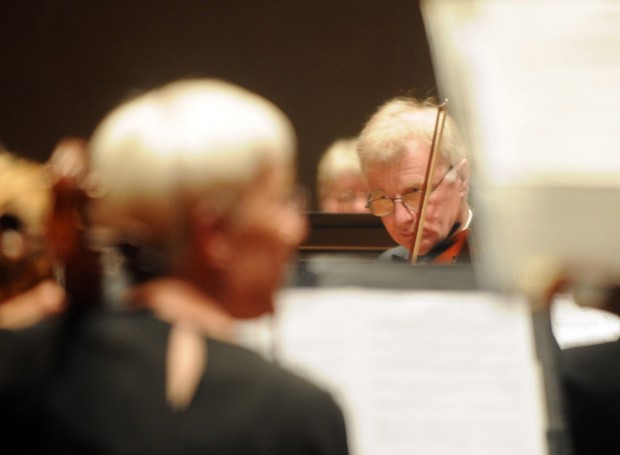
It has been 30 years since Tim Secomb and the Southern Arizona Symphony Orchestra first played Shostakovich’s Fifth Symphony.
But the memory is as fresh as if it were yesterday.
The piece has that effect on a musician. Like many violinists who have played it, Secomb was drawn into the Russian composer’s intense emotions.
“It is absolutely an incredible symphony. It’s very powerful,” said Secomb, who will play the Shostakovich again with SASO in two concerts this weekend.
“That symphony made an enormous impression on me when we did it in the 1980s, and I’ve been looking forward to doing it again,” he said.
Secomb said he and his SASO colleagues had suggested performing the piece to Music Director Linus Lerner for about a year. Lerner said making it the finale of a season that has pushed the volunteer ensemble to new artistic heights seemed fitting.
“It’s a piece for musicians. Everybody wants to play it,” Lerner said last week, days after the orchestra first rehearsed the work in full. The piece, he said, challenges the orchestra at a “higher level than what we’ve done through the whole season.”
That’s saying a lot when you consider the orchestra performed the 1919 version of Stravinsky’s “Firebird Suite” last November.
“The Shostakovich is a tour-de-force symphony,” said Lerner, describing how the strings are played at particularly high octaves throughout while percussion, winds and brass alternate from very low to high.
Shostakovich penned his Symphony No. 5 in 1937 after his fall from political favor in the Soviet Union.
Joseph Stalin himself is believed to have panned (writing anonymously in the Communist Party newspaper Pravda) Shostakovich’s opera “Lady Macbeth of the Mtsensk District,” which premiered in 1936. An earlier article in Pravda had decried all of Shostakovich’s music as “muddle.”
Shostakovich retreated and focused his attention on the relatively safe exercise of film composing while quietly working on his Fifth Symphony.
The symphony is musically more conservative and appears to toe the party line. But where Communist Party leaders heard patriotic flashes, average listeners at its 1937 premiere heard the mournful acknowledgement of the millions of countrymen who had died under the Stalin regime.
“It’s very powerful,” Lerner said. “And it’s a statement that Shostakovich was making against Stalin. It’s based on some folk music, but in language that is very impressive. I don’t even have words; it’s just a wonderful work. And it’s a pleasure to conduct. It’s exhilarating.”
SASO opens this weekend’s concerts with Tucson composer David Isaac’s Patriotic Overture and Bottesini’s Concerto for Double Bass, No. 2 in B minor with guest bass players Waldir Bertipaglia and Catalin Rotaru.
If you go
- What: Southern Arizona Symphony Orchestra season finale.
- 7:30 p.m. Saturday at DesertView Performing Arts Center, 39900 S. Clubhouse Drive in SaddleBrooke.
- 3 p.m. Sunday at St. Andrew’s Presbyterian Church, 7575 N. Paseo del Norte.
- Tickets: For SaddleBrooke, $21 in advance at tickets.saddlebrooketwo.com and $23 at the door; 825-2818. For St. Andrew’s, $20 online at www.sasomusic.org or at the door; children 17 and younger are free.
- Program: Isaac’s Patriotic Overture Bottesini’s Concerto for Double Bass, No. 2 in B minor, featuring bassists Waldir Bertipaglia and Catalin Rotaru. Shostakovich’s Symphony No. 5 in D minor.
